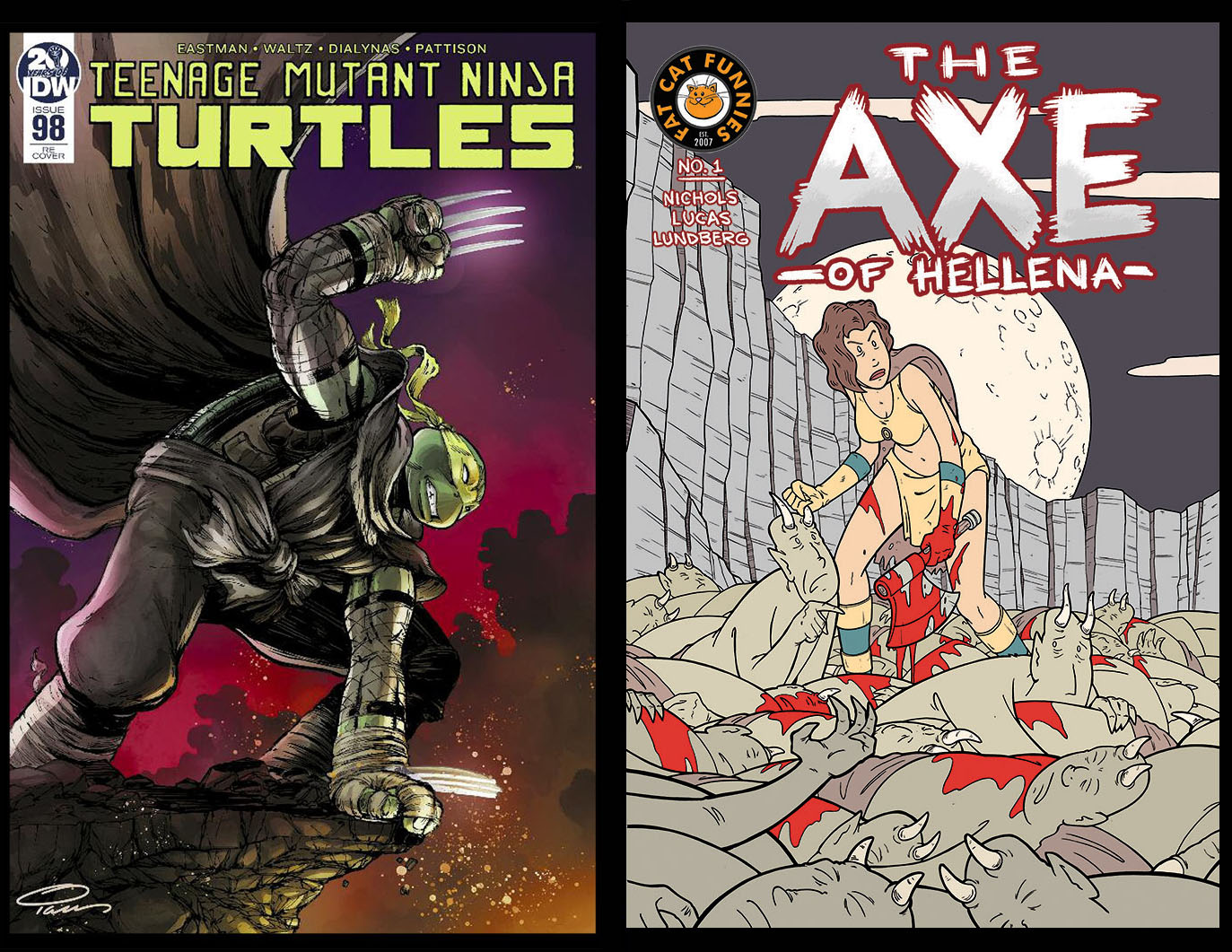
I've got something special for ya today. I, your beloved illustrator of Arsenic Lullaby, shall have a little one on one interview with Ian Chase Nichols , a beloved comic book illustrator in his own right!
Ian has done work on Teenage Mutant Ninja Turtles, the Tick, and many others and is about to release his own self published work AXE OF HELLENA!
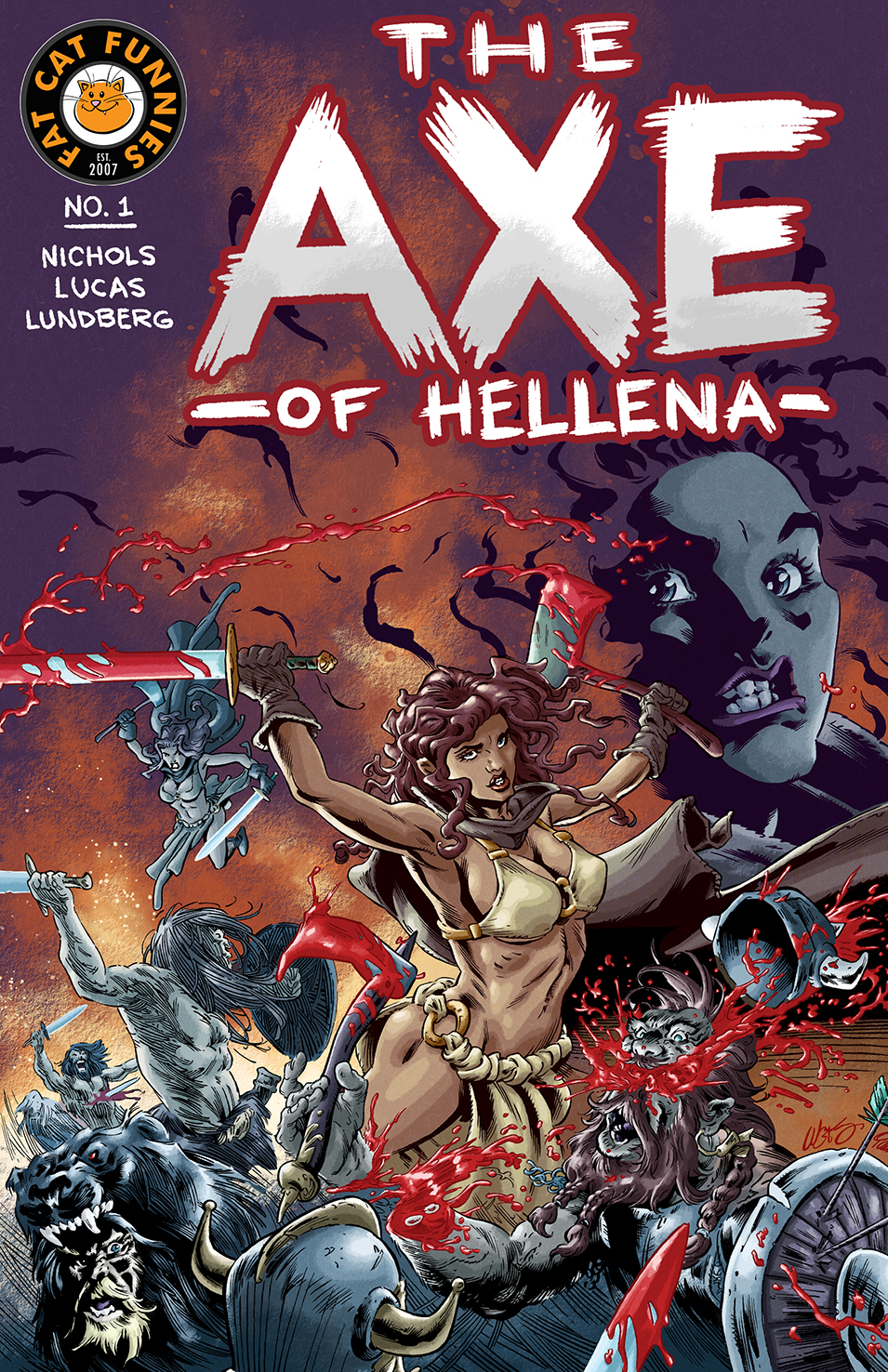
First, here's Ian's synopsis of his upcoming series!
In amongst the blazing blades, spilt blood, fantastical monsters, and occasional nudity, The Axe of Hellena is one person's quest to discover their true purpose, what genuinely makes them happy, and how that changes over time. Hellena experiences the certainty and confidence of youth in a quest that she believes is her life's purpose, but things inevitably change. Knowledge and experience force her to reevaluate what her purpose is and what truly makes her happy. Something akin to Aristotle's, "The more you know, the more you realize you don't know," but with monsters and swords.
and now...how's about he and I talk shop a bit, yeah?
why did you choose this genre? Is it something you wanted to do and wrote to that genre or did you just have the story in your head, or the character in your head first...where do YOU start with a project like this?
I enjoy the Fantasy genre. My father was a fan of it, and he introduced me to it very young with the likes of J.R.R. Tolkien, the Secret of Nimh, and the Ralph Bakshi Fantasy movies like Wizards and The Lord of the Rings. At some point, he gifted me nearly every paperback that RE Howard ever wrote, and I read them to pieces in my adolescent years. It established my enjoyment of the genre. Around that time, I discovered the Conan Comics, Savage Sword of Conan, magazines like EPIC, and other fantasy works in comic form, and that connected those dots for me.
The other reason I chose this genre is that I like drawing a less polished world and more organic shapes. Hellena's world is messy, and it's aged with character. I don't get as much enjoyment out of drawing clean technology, cars, or highly geometric forms. I can draw cars, architecture, or whatever, but it's not what I do for fun and on my own dime.
I'd say that's almost opposite for me. Non organtic stuff like buildings and cars have universally visual structure. By that I mean there's less guess work, less reliance on instinct to lay out thier form. I'd wring my hands constantly when it comes to something like trees "it that too many branches? Not enough leaves?" hahaha. With a car I know it had four wheel and where they should be, no guess work. LOL
If I hop on my soapbox to talk genre... Unfortunately, comics are broadly misconstrued as being a genre and not a medium that is exclusively and permanently attributed to superheroes. Science Fiction is usually more broadly credited as a genre with a greater capacity for depth than others, with things like Black Mirror and The Twilight Zone. I don't believe that genre limits a story's capacity for quality. Comics and sequential art can do things with storytelling that no other medium can or does. It's entirely up to the author's abilities and execution with whatever genre they've picked. That's what I am trying to do in the Fantasy genre, while having a good time at it.
Oh, you are preaching to the choir on that score. The comics industry as a whole has done itself a disservice letting itself become typecast as equating to super hero stories. The medium is far better suited for Horror, comedy and fantasy because it can manipulate the perception of timing. A very important tool for getting the most out of all three of those.
So, Is it something you wanted to do and wrote to that genre or did you just have the story in your head, or the character in your head first...where do YOU start with a project like this?
Hellena first came into existence on a flight. I was bored and doodling in my sketchbook, and I drew a tough lady with curly hair, an axe, and some disembodied heads at her feet. The name was just something that came to me and made me smile.

I continued to draw her in my sketchbook, on the backs of memos, and whenever I had. Drawings of Hellena would always get me through Artist's Block. For whatever reason, I kept hiring artists to draw her too (with their permission to one day publish the work). In 2019, I did some new pages, and brought them to conventions to shop the book around. Several companies were interested. One of them was really serious, and then the pandemic hit. They pulled the deal, and I was left with my pages and art from some all-time great comic artists. I decided to do it myself, and I started putting pages on my website. I'd hope to collect them when there were enough pages, but I'd have to find a printer that I could afford. We've gotten to where both of those things have come true, so I'm going to make some print copies of issue one.
It's often a tenacious perch to be on...reliying on a publisher to follow through, no one'll ever be more serious about seeing your work reach an audience than you.
So as you'd sketch her...did you have her overall personality kind of in your head already? Or did you like how the visual turned out and added the personality as you begin writing the story? I ask because when I come up with, or more accurately a character appears from my scribbles, I more or less know who they are what they are like right then and there. In some cases they evolve but for the most part I know who they are before I have anything for them to do/story.
With Hellena, I know her character completely. I can think of any battle, plot idea, or scenario, and I will know how she'd respond to it. I'm completely comfortable drawing her, and the visualized and finished version of her in my head is in my drawing style, so when I draw her, it looks correct. When I draw other characters, Batman, TMNT, the Tick, whoever, the finished/correct version in my head is not drawn by me, but in another artist's style. It takes me drawing other people's characters many many times for me to be comfortable with the outcome on-paper.


With these things in mind, when I draw Hellena, it's more like we're IN an adventure together, rather than me trying to figure out how to draw her in someone else's story ON an adventure (if that makes sense?). I think that's why, when I have Artist's Block, she helps me out of it.
You are the writer and illustrator here, you don't have to worry about miscommunication from what the writer envisioned to how you'd draw out the scene. So, did you write a full script, an outline, or just start laying out pages until you got to the end...which is what I do hahah.
When I pitched it to publishers, I pitched a 6-issue arc. I had a complete first issue script, half of issue one penciled and inked, a cover, pinups and covers by established professionals, and plot outlines for each of the remaining five issues. I also had other established writers willing to do backup stories for each of the first six issues. Its level of completion was part of the motivation behind doing something with it. I also felt I owed it to the artists I'd commissioned drawings from to get them published.
My writing process for myself usually starts with writing the thing in prose and notes. It gets me from A to Z with major action and plot points. I then turn that into an outline. From that outline, I do thumbnails with balloons and captions placements mapped out. At each step, I'm adding and refining the dialog. I like succinct dialog with a certain beat to it, to the extent that naturalism is not always necessarily the goal.
I absolutely act out scenes, and I assume my neighbors see me and judge me for this. If I have to write a finished script, it's after the thumbnails, when I've solved as many of the visual and design problems of any given story.
huh, I can't say I physically act out anything...but I mentally have a sort of animated episode going on in my minds eye , and probably voice act out the dialogue more than I'd like to admit.
Which page was the most fun to draw...that's probably hard to choose, don't think too hard. What about it made it fun? (feel free to explain any techniques or tools)
I like sequences, so I will say pages 20-23. It's the height of the story, there's a good beat to it visually and text-wise. Those were all drawn in rough pencils and marker, then I lightbox to bristol in pencil and ink, and I colored and lettered them in photoshop. The payoff should be the best part, right?
I'd say yes, in an action/adventure genera. Possibly horror as well. I know in the comedy comics I do, I try (TRY) to have the payoff be somewhat less visually interesting than the set up, so the reader doesn't notice the punchline first.
Like you mentioned earlier there are many tools at your disposal in comic book format and this format gives you the ability to use them incorrectly for affect and gives each one a different use and advantage depending on what tone of story you're telling. For instance, I've noticed your page layouts for Hellena are less whimsical but more impactful than the pages I've seen you do for the Tick. In both instances setting a different tone for the different types of story.
Do you instinctively or intentionally lay out pages differently depending on the genre you're illustrating? More or less panels, different sizes and shapes of panels, or that sort of thing?
I do approach different genres and types of books differently. I try to tailor my approach, narrative structure, and finish in a way that I think will deliver the best possible outcome for any particular project and its intended audience. The best description of comic pages and sequential art I've heard was that a comic book page is a mixture of graphic design and illustration with the addition of the concept of time.
You can see into the future on every two-page spread of panels after page one, and you see the present and past all simultaneously. Different panel sizes, shape, and densities all take a different amount of time to read, and they can contain vastly different periods of time between panels. The page turn is the only true surprise in a comic because the reader can't see it yet. As the writer and artist, all of that can be synchronized and planned at the same time. With a creative team (writer, artists, editor, etc.), we all have to communicate those steps and either be on the same page or be OK with however the next person on the chain how to interpret the work.
With Hellena, I get to decide the mechanical and structural storytelling from the jump. The entirety of the issue, the individual pages, and the panels are all planned intentionally for the pacing reveals and payoffs--as is the time between panels. For example, I opened page one of issue one with a nine panel grid because I wanted to slow the reader down. Each of those nine panels is a single shot from a different story Hellena participated in in the past, without showing Hellena at all.
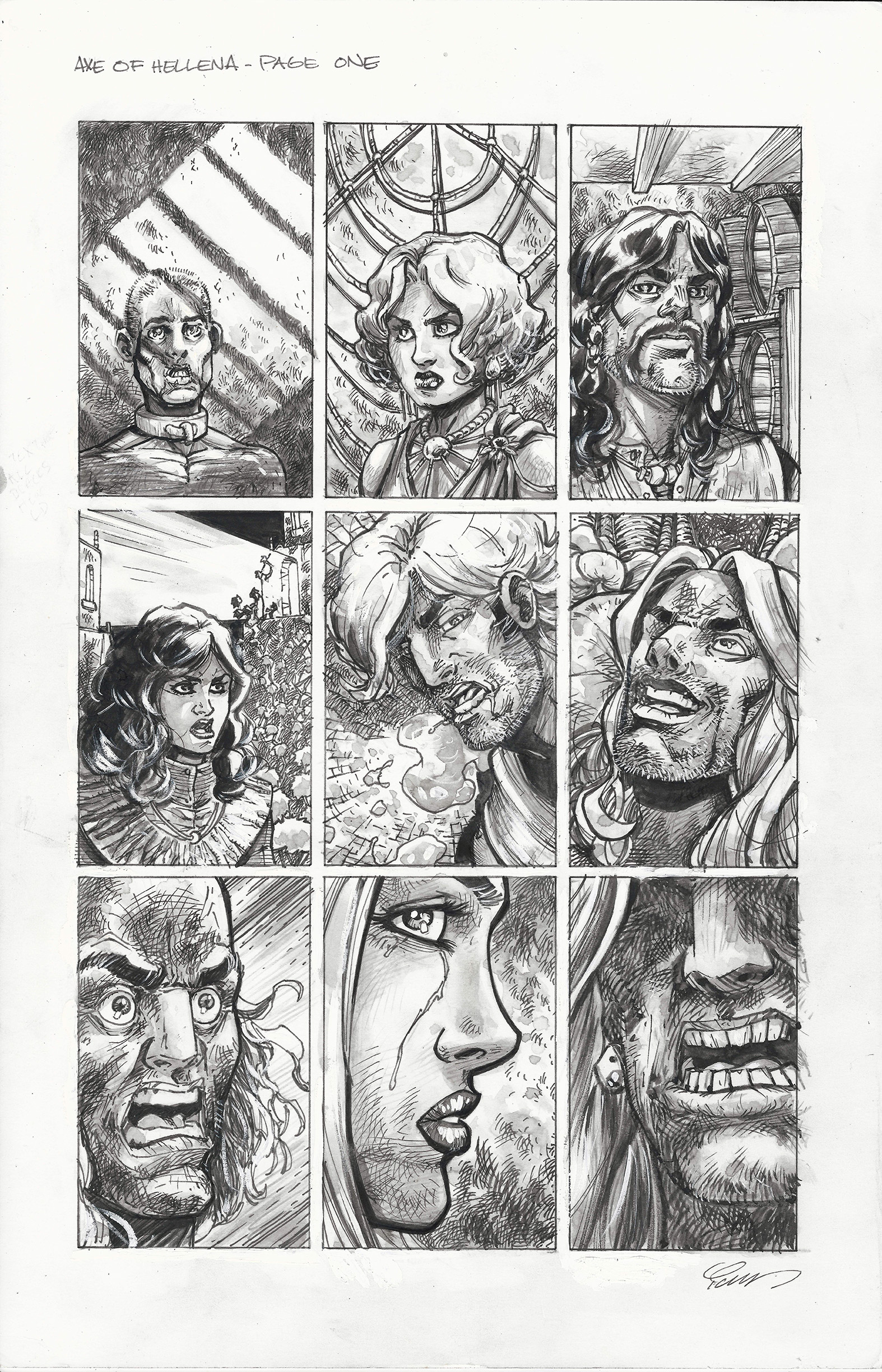
Each panel has some visual evidence that reveals something about each of those stories and of Hellena. Then, I hit the reader with a big splash page of Hellena killing a guy, thus fully revealing her for the first time.
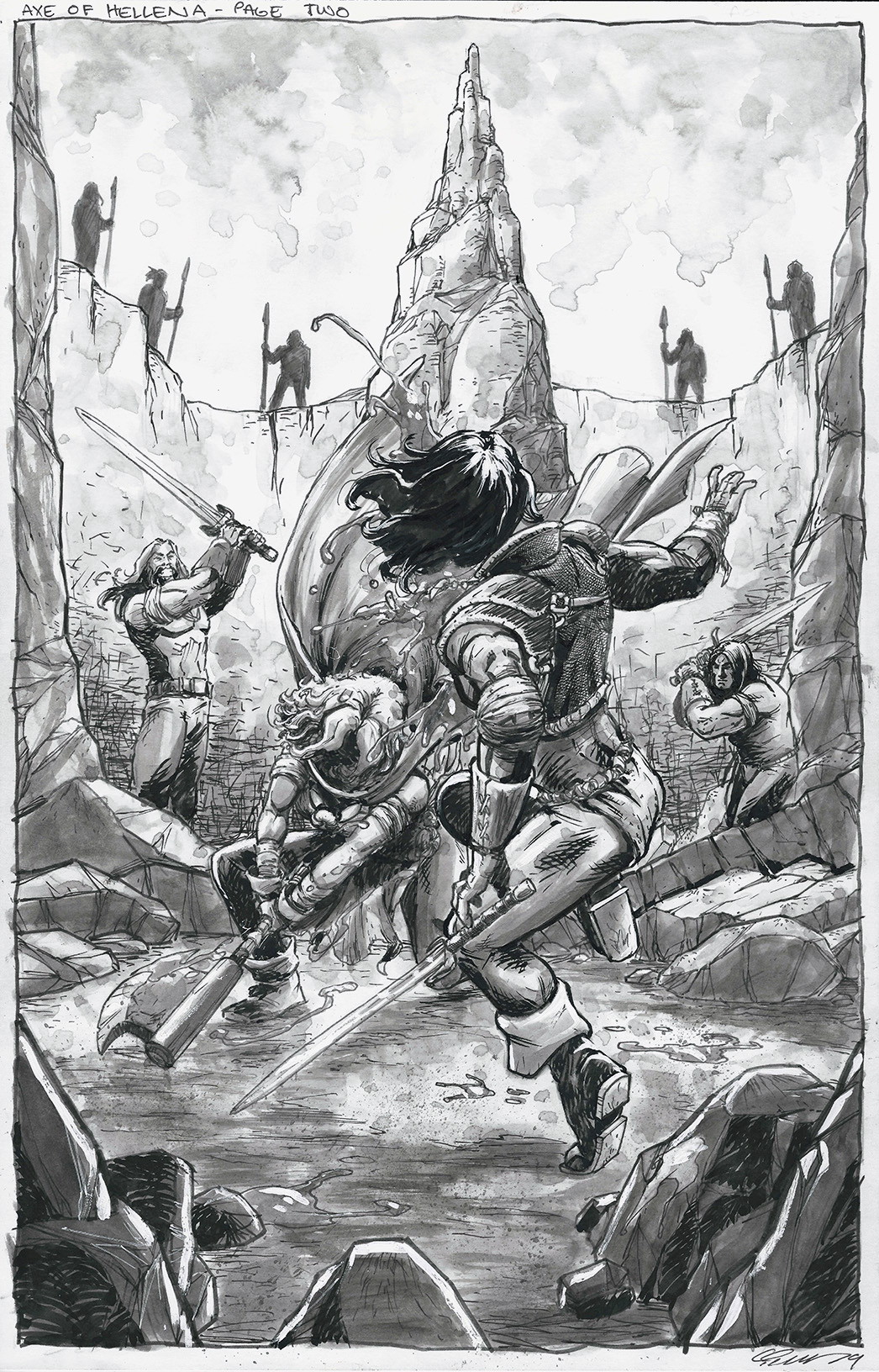
The slow and fast panels were put that way for what I thought would deliver the most impact to open the book and introduce the character.
When I'm not writing the project, I'm being told what to draw. With books like The Tick, Ironface, etc. it's my job to deliver, to the best of my abilities, what they're asking for. If I see a better way to do things from a storytelling perspective, I will make suggestions. Sometimes, I have nothing to add. If I see something that I think can improve or add to a story visually, I suggest that in the thumbnail or preliminary drawing stage. I'll draw multiple rough versions and give alternatives there to discuss those ideas.
Some publishers, editors, and writers are totally open to listening and some just aren't. It's their money, so they make the final call, and I know that going in. The people with the final call, the editors and publishers, can have a lot of say in what shows up on the final printed page. I think they should get more recognition, both good and bad, when the final works are judged.
Personally, I end up doing a bit of research on anything I'm writing or drawing...maybe visual research like getting picks of what a tommy gun looks like exactly, or making sure the CIA had been founded and operating at the time of the story, whatever. Did you need to do any of that with this AND...if so, what rabbit hole did you end up going down?
For this book, I have had enough genre research to last me. I do look up styles of weapons, tools, and different ancient architectures, art, and writing. I enjoy looking at different ruins from around the world to pull some things from that I can't think of. I've been using more photo reference with my work overall, but I am not going for photo-realism. I also tend to look at pictures of different animals as a starting point for designing creatures. Deep sea and desert creatures I find particularly inspiring.
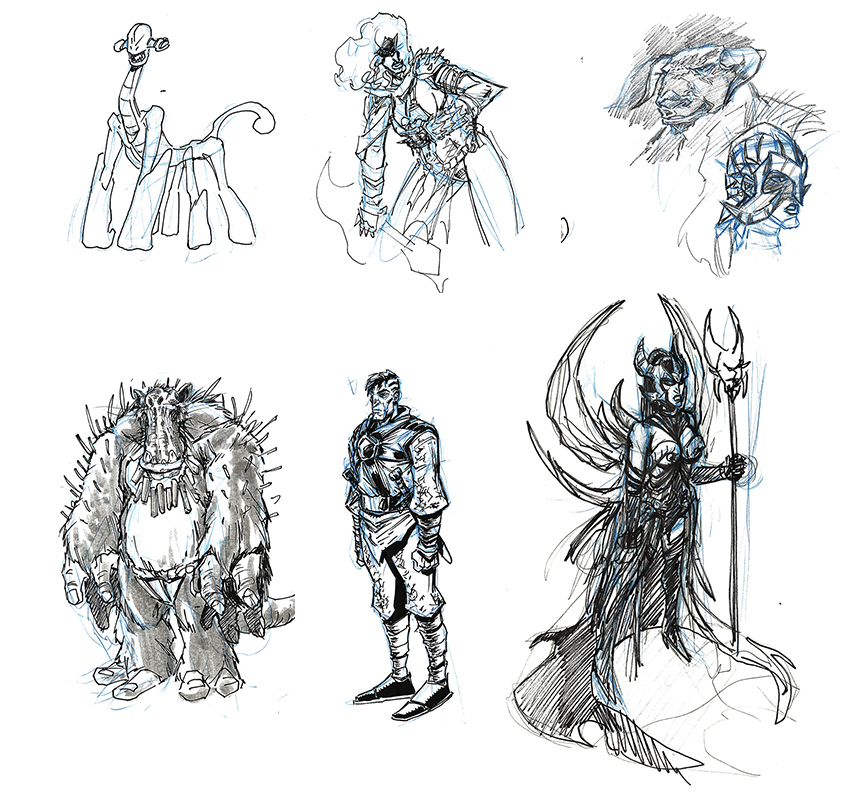
Good on you for all of that. I especially think researching and understanding the anatomy of animals is VERY underrated. Even if you are drawing something that doesn't exist, like say a dragon or even an werewolf...having a good idea of how the muscles attach to bone, how skin or scales or hair look and flex and buckle really gives everything a bit more of a feeling of actually existing in the world of that story. If someone is very adept at drawing a muscle bound warrior, but has no idea how the facial structure of a bear looks like...it's obvious and can take you right out of the story
Well...I could talk to Ian for many more pages, but he's a busy man...and plugging someone else's work really hurts my ego. So, that is all for now, but later in the month he and I , via livestream, are going to show you how we lay out a comic book page. That will either be informative or entertaining depending on how much we struggle to get one right, hahaha.
IN the meantime...Here's how to find Ian and his work! Feel free to bug him about getting on Hive!
The Axe of Hellena can be read for FREE (with no signups, no SPAM emails, and no pop-ups) at:
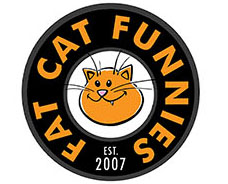
https://www.fatcatfunnies.com/
Printed Copies will be available directly at Conventions from Ian Chase Nichols
Sketch covers with hand drawn original art covers will be available at iancnichols.com (follow him on social media for availability announcements)
Instagram: @IanChaseNichols
Twitter: @IanCNichols
Facebook: Ian Chase Nichols (https://www.facebook.com/ian.c.nichols.9/)
as always MY homebase is here
https://www.arseniclullabies.com/

and just for the hell of it...I'm on alla these also ( though some less often than others.)
Instagram- https://www.instagram.com/arsenic_lullaby_official/
twitter- https://twitter.com/arsenic_lullaby
torum- https://www.torum.com/u/arseniclullaby
bitchute- https://www.bitchute.com/channel/arsenic_lullaby/
youtube- https://www.youtube.com/user/arseniclullabycomics

The rewards earned on this comment will go directly to the person sharing the post on Twitter as long as they are registered with @poshtoken.
Cool stuff. I always love getting some insight into how creative people work. I will check out his comic. Thanks for sharing this with us on Hive.
He's defiantly a guy who cares about his craft. Once we do the "how to" video on laying out a page, I'll have it up here for everyone
Your content has been voted as a part of Encouragement program. Keep up the good work!
Use Ecency daily to boost your growth on platform!
Support Ecency
Vote for Proposal
Delegate HP and earn more